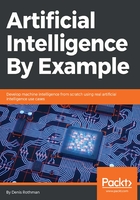
Manage the Power of Machine Learning and Deep Learning
Mastering machine learning and deep learning is proportional to your ability to design the architectures of these solutions. As developers, we tend to rush to some sample code, run it, and then try to implement it somehow. That's like going to a big city we don't know, with no map and no guiding system, and trying to find a street. Even worse, it's like trying to build a 50-storey building with no architect or plans.
An efficient, well-thought architecture will lead to a good solution. Deep learning networks are data flow graph calculations as shown in Chapter 4, Become an Unconventional Innovator. A node or edge is, in fact, a mathematical operation. The lines connecting these nodes are data flows and mathematical representations. Tools such as TensorFlow and TensorBoard have been designed for data flow graph representations and calculations. Without using TensorBoard, the graph representation of a network, there is little to no chance of understanding and designing deep networks.
The sponsors of a project need to understand the concepts of a given solution. This chapter explores how to use these tools and, at the same time, make a successful presentation to a CEO, top managers, or your team.
The following topics will be covered in this chapter:
- Building a feedforward neural network (FNN) with TensorFlow
- Using TensorBoard, a data flow graph, to design your program
- Using the data flow graph to write a program
- A cost function, a loss function
- Gradient descent
- Backpropagation in a feedforward network
- Presenting an FNN to a team or management